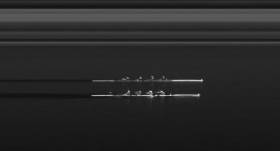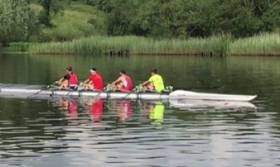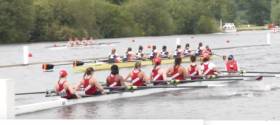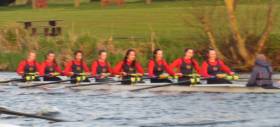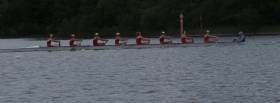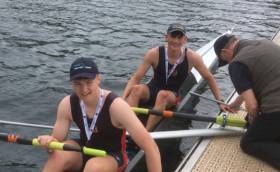Displaying items by tag: Enniskillen
Cork Clubs on a Run at Irish Championships
#Rowing: Cork clubs had a set of good results in the first session of Sunday finals at the Irish Rowing Championships at the National Rowing Centre.
Cork Boat Club's junior women's pair started the ball rolling, while Skibbereen then took their second title of Championships as Aodhan Burns proved a strong winner of the lightweight single sculls.
Margaret Cremen of UCC had a huge win in the lightweight single sculls, and Lee added the junior men's double to the junior quadruple title they had won on Saturday.
The tighest finish came in the men's club coxed four. NUIG made a tremendous effort to catch St Michael's of Limerick but they fell short by just .329 of a second.
Commercial of Dublin and Fermanagh's Enniskillen Royal Boat Club are having a good reatta. Enniskillen won the men's intermediate pair, while Commercial won the womens intermediate coxed four.
NUIG and Enniskillen Shine at Irish Rowing Championships
#Rowing: NUIG had a very good first day at the Irish Championships at the National Rowing Centre, taking four titles.
They won the women's senior four, the women's intermediate eight and the women's club coxed four. Sadhbh O'Connor and Fiona Murtagh added the women's senior double sculls for the Galway club.
Enniskillen took two notable titles: their men's junior eight came through under pressure from Colaiste Iognaid, and the women's junior four won from Bann.
Fionnan Crowley retained his title in the men's senior single sculls. The Castleconnell man - a brother of Aileen, who was doing well in the Ireland pair at Rotterdam - won by under a length from Niall Beggan of Commercial, who came at him hard in the closing stages.
UCD's senior four also successfully defended their title.
Tom Kelly won the junior single - the first Championships for the Kenmare club. Kelly, who turns 17 next month, is coached by Noel Casey, who is 85. Casey as based in Britain for decades and coached British women's crews to the Los Angeles Olympic Games.
Carlow's Sadhbh Scully and Ciara Egan won the women's junior double - a first title at this level for the club.
Trinity won the men's club eight in a good race, while Cork Boat Club won the men's intermediate coxed four, and Anna Liffey the women's intermediate pair.
NUIG pushed Queen's hard in the men's novice coxed quadruple, but the Belfast men came through. The women's novice coxed quad from Queen's also won, giving them two victories on a busy day.
Surprise Defeat for Enniskillen at Henley Royal Regatta
#Rowing: Enniskillen were beaten in the Fawley Cup for junior men’s quadruples at Henley Royal Regatta this morning. Christiana Roklub of Norway moved into the lead and while they lost a little momentum when they were forced by the umpire to adjust their steering, they survived a late push by Enniskillen to win by just a third of a length.
Henley Royal Regatta, Day Two (Irish interest)
Fawley Cup (Junior Men’s Quadruple): Christiana Roklub, Norway bt Enniskillen RBC 1/3 l.
#Rowing: Enniskillen Royal Boat Club made their exit from the Diamond Jubilee for junior women’s quadruples in the first round today. Notts County eked out a lead and held on to it under pressure from the Fermanagh girls. They won by less than a length.
Henley Royal Regatta – Day One (Irish interest)
Thames Cup (Men’s Eights, Club): Commercial bt Nottingham RC 3½ l.
Diamond Jubilee (Junior Women’s Quadruple): Notts County RA bt Enniskillen Royal Boat Club
#Rowing: A very strong American crew, St Paul’s, beat Enniskillen in the final of the Junior Eight at Henley Women’s Regatta today. The Americans sprinted into an early lead. Enniskillen kept the pressure on, but the power of their opponents told. They won by two and half lengths.
Henley Women’s Regatta (Irish interest): Junior Eight (Peabody Cup) – Final: St Paul’s School, United States bt Enniskillen 2½ l.
Enniskillen Race to Final of Henley Women's Regatta
#Rowing: Enniskillen qualified confidently for the final of the Junior Eight at Henley Women’s Regatta today. They got a good start in the semi-final and built it into a clear water lead over Henley Rowing Club. The Fermanagh crew won by one and three-quarter lengths. In the final they will face the strong United States crew, St Paul’s School.
#Rowing: UCD made their exit at Henley Women’s Regatta, but Enniskillen moved into the semi-finals today. Newcastle University made a fast start in their quarter-finals of the Aspirational Academic Eights against UCD and built it into a clearwater lead.
Enniskillen were all set to take on Wimbledon High School, but in the event they were given a row over as Wimbledon did not compete due to a disqualification.
UCD and Enniskillen Progress at Women's Henley
#Rowing: UCD’s eight beat Jesus College, Cambridge, to progress to the quarter-finals at Henley Women’s Regatta today. The Irish crew will take on Newcastle University at 4.44 pm.
Enniskillen’s junior 18 eight came through a time trial to qualify for their quarter-final. They will take on Wimbledon High School at 3.40 with strong hopes of moving into Sunday’s semi-final.
#Rowing: Bann won the women's junior 18 eights with some style at Athlone Regatta today. In a battle of Northern Ireland clubs, the women in red and white were two lengths ahead of Enniskillen, with Coleraine GS third.
The women's junior 18 fours came late in the day and was a terrific battle. Commercial produced a cracking finish to win by a length from Enniskillen, with Bann third.
Coleraine's Molly Curry was a convincing winner of the women's junior 18 single, while Brian Colsh of Sligo was the men's junior sculling winner.
Galway's St Joseph's won the men's junior 18 eight, while Bann's good day included a win in the men's junior 18 four.
Enniskillen in the Medals at National Schools Regatta
#Rowing: Enniskillen’s Sam Balcombe and Peter Murphy took a fine third place in the men’s Championship Pair at the National Schools Regatta at Dorney Lake today.
On Saturday, Enniskillen had won gold in the Junior 16 Girls coxed four by a big margin.
Ryan Spelman of St Michael’s took his place in the A Final of the Championship Single Sculls, and finished well to challenge the leaders. He took fifth.
Coleraine Grammar School also took fifth in the final of the Junior 16 Girls Double.


























